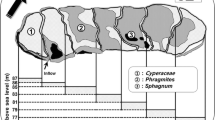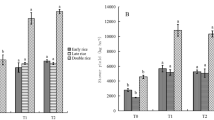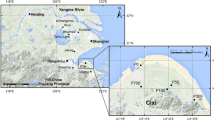Abstract
Taking fresh soil samples from a rice–wheat rotation field (RW), a permanently flooded rice field (PF), and a double-rice cropping field (DR: DRE for the early rice; DRL for the late rice), we measured the CH4 production potential (MPP), the relative contribution of acetate-dependent methanogenesis (ƒac), soil properties, and methanogenic archaeal communities mainly in order to reveal the temporal variation and corresponding influencing factors of methanogenic pathways in paddy soils. Consistent with the change in dissolved organic C (DOC) content, the MPP generally decreased with rice growth in RW and DRL while increasing in PF and DRE. Based on the measurements of stable carbon isotopes, the estimated ƒac-value in PF dropped sharply from 54%-61% at the tillering stage to 30%-35% at the booting stage and rose again at the ripening stage. This variation pattern was positively correlated with that of acetate content, perhaps resulting from the activation of acetoclastic Methanosarcina. In contrast, the ƒac-value in RW and DR rose from 20%-44% at the tillering stage to 49%-59% at the ripening stage, possibly owing to the increase in the relative abundance of acetoclastic Methanothrix. The relative abundance of Methanosarcina in PF was 3%-4% higher than those in RW and DR, whereas that of Methanothrix was 3%-7% lower (P < 0.05). Soil acetate, DOC, and moisture contents significantly affected the methanogenic community composition. Our results demonstrate that the temporal variation of methanogenic pathways was influenced by the relative abundance of acetoclastic methanogens depending on the acetate level.




Similar content being viewed by others
Data availability
The datasets of the current study are available from the corresponding author on reasonable request.
References
Angel R, Matthies D, Conrad R (2011) Activation of methanogenesis in arid biological soil crusts despite the presence of oxygen. PLoS ONE 6:e20453. https://doi.org/10.1371/journal.pone.0020453
Angel R, Claus P, Conrad R (2012) Methanogenic archaea are globally ubiquitous in aerated soils and become active under wet anoxic conditions. ISME J 6:847–862. https://doi.org/10.1038/ismej.2011.141
Asakawa S, Hayano K (1995) Populations of methanogenic bacteria in paddy field soil under double cropping conditions (rice-wheat). Biol Fertil Soils 20:113–117. https://doi.org/10.1007/BF00336589
Bertora C, Cucu MA, Lerda C, Peyron M, Bardi L, Gorra R, Sacco D, Celi L, Said-Pullicino D (2018) Dissolved organic carbon cycling, methane emissions and related microbial populations in temperate rice paddies with contrasting straw and water management. Agr Ecosyst Environ 265:292–306. https://doi.org/10.1016/j.agee.2018.06.004
Bilek RS, Tyler SC, Sass RL, Fisher FM (1999) Differences in CH4 oxidation and pathways of production between rice cultivars deduced from measurements of CH4 flux and δ13C of CH4 and CO2. Global Biogeochem Cycles 13:1029–1044. https://doi.org/10.1029/1999GB900040
Cai ZC, Tsuruta H, Minami K (2000) Methane emission from rice fields in China: Measurements and influencing factors. J Geophys Res-Atomos 105:17231–17242. https://doi.org/10.1029/2000JD900014
Cao YC, Sun GQ, Han Y, Sun DL, Wang X (2008) Determination of nitrogen, carbon and oxygen stable isotope ratios in N2O, CH4, and CO2 at natural abundance levels by mass spectrometer. Acta Pedol Sin 45:249–258
Chen H, Zhu QA, Peng CH, Wu N, Wang YF, Fang XQ, Jiang H, Xiang WH, Chang J, Deng XW, Yu GR (2013) Methane emissions from rice paddies natural wetlands, lakes in China: synthesis new estimate. Global Change Biol 19:19–32. https://doi.org/10.1111/gcb.12034
Conklin A, Stensel HD, Ferguson J (2006) Growth kinetics and competition between Methanosarcina and Methanosaeta in mesophilic anaerobic digestion. Water Environ Res 78:486–496. https://doi.org/10.2175/106143006X95393
Conrad R (2007) Microbial ecology of methanogens and methanotrophs. Adv Agron 96:1–63. https://doi.org/10.1016/S0065-2113(07)96005-8
Conrad R (2020a) Importance of hydrogenotrophic, aceticlastic and methylotrophic methanogenesis for methane production in terrestrial, aquatic and other anoxic environments: A mini review. Pedosphere 30:25–39. https://doi.org/10.1016/S1002-0160(18)60052-9
Conrad R (2020b) Methane production in soil environments—anaerobic biogeochemistry and microbial life between flooding and desiccation. Microorganisms 8:881. https://doi.org/10.3390/microorganisms8060881
Conrad R, Klose M, Claus P (2002) Pathway of CH4 formation in anoxic rice field soil and rice roots determined by 13C-stable isotope fractionation. Chemosphere 47:797–806. https://doi.org/10.1016/s0045-6535(02)00120-0
Conrad R, Klose M, Lu YH, Chidthaisong A (2012) Methanogenic pathway and archaeal communities in three different anoxic soils amended with rice straw and maize straw. Front Microbiol 3:4. https://doi.org/10.3389/fmicb.2012.00004
De Vrieze J, Hennebel T, Boon N, Verstraete W (2012) Methanosarcina: The rediscovered methanogen for heavy duty biomethanation. Bioresource Technol 112:1–9. https://doi.org/10.1016/j.biortech.2012.02.079
Dubey SK, Singh A, Singh RS, Upadhyay SN (2013) Changes in methanogenic population size and CH4 production potential in response to crop phenology in tropical rice field. Soil Biol Biochem 57:972–978. https://doi.org/10.1016/j.soilbio.2012.07.001
Fetzer S, Bak F, Conrad R (1993) Sensitivity of methanogenic bacteria from paddy soil to oxygen and desiccation. FEMS Microbiol Ecol 12:107–115. https://doi.org/10.1111/j.1574-6941.1993.tb00022.x
Fey A, Conrad R (2000) Effect of temperature on carbon and electron flow and on the archaeal community in methanogenic rice field soil. Appl Environ Microbiol 66:4790–4797. https://doi.org/10.1128/AEM.66.11.4790-4797.2000
Fey A, Claus P, Conrad R (2004) Temporal change of 13C-isotope signatures and methanogenic pathways in rice field soil incubated anoxically at different temperatures. Geochim Cosmochim Acta 68:293–306. https://doi.org/10.1016/s0016-7037(03)00426-5
Food and Agriculture Organization of the United Nations Statistics Division (FAOSTAT) (2023) https://www.fao.org/faostat/en/#data/QCL/visualize. Accessed 6 Mar 2023
Fu B, Jin X, Conrad R, Liu HB, Liu H (2019) Competition between chemolithotrophic acetogenesis and hydrogenotrophic methanogenesis for exogenous H2/CO2 in anaerobically digested sludge: impact of temperature. Front Microbiol 10:2418. https://doi.org/10.3389/fmicb.2019.02418
Games LM, Hayes JM, Gunsalus RP (1978) Methane-producing bacteria: Natural fractionations of the stable carbon isotopes. Geochim Cosmochim Acta 42:1295–1297. https://doi.org/10.1016/0016-7037(78)90123-0
Gao B, Huang T, Ju XT, Gu BJ, Huang W, Xu LL, Rees RM, Powlson DS, Smith P, Cui SH (2018) Chinese cropping systems are a net source of greenhouse gases despite soil carbon sequestration. Global Change Biol 24:5590–5606. https://doi.org/10.1111/gcb.14425
Gelwicks JT, Risatti JB, Hayes JM (1994) Carbon isotope effects associated with aceticlastic methanogenesis. Appl Environ Microbiol 60:467–472. https://doi.org/10.1128/aem.60.2.467-472.1994
Hao QJ, Jiang CS, Chai XS, Huang Z, Fan ZW, Xie DT, He XH (2016) Drainage, no-tillage and crop rotation decreases annual cumulative emissions of methane and nitrous oxide from a rice field in Southwest China. Agr Ecosyst Environ 233:270–281. https://doi.org/10.1016/j.agee.2016.09.026
Intergovernmental Panel on Climate Change (IPCC) (2021) Climate Change 2021: The Physical Science Basis. Cambridge University Press, Cambridge. https://doi.org/10.1017/9781009157896
Intergovernmental Panel on Climate Change (IPCC) (2022) Climate Change 2022: Mitigation of Climate Change. Cambridge University Press, Cambridge. https://doi.org/10.1017/9781009157926
Jetten MSM, Stams AJM, Zehnder AJB (1990) Acetate threshold values and acetate activating enzymes in methanogenic bacteria. FEMS Microbiol Ecol 73:339–344. https://doi.org/10.1016/0378-1097(90)90768-L
Jetten MSM, Stams AJM, Zehnder AJB (1992) Methanogenesis from acetate: a comparison of the acetate metabolism in Methanothrix soehngenii and Methanosarcina spp. FEMS Microbiol Rev 88:181–197. https://doi.org/10.1016/0378-1097(92)90802-U
Ji Y, Liu PF, Conrad R (2018) Change of the pathway of methane production with progressing anoxic incubation of paddy soil. Soil Biol Biochem 121:177–184. https://doi.org/10.1016/j.soilbio.2018.03.014
Ji Y, Conrad R, Xu H (2020) Responses of archaeal, bacterial, and functional microbial communities to growth season and nitrogen fertilization in rice fields. Biol Fertil Soils 56:81–95. https://doi.org/10.1007/s00374-019-01404-4
Ji Y, Xu YJ, Zhao MY, Zhang GB, Conrad R, Liu PF, Fong ZZ, Ma J, Xu H (2022) Winter drainage and film mulching cultivation mitigated CH4 emission by regulating the function and structure of methanogenic archaeal and fermenting bacterial communities in paddy soil. J Environ Manage 323:116194. https://doi.org/10.1016/j.jenvman.2022.116194
Jia ZJ, Cai ZC, Xu H, Li XP (2001) Effect of rice plants on CH4 production, transport, oxidation and emission in rice paddy soil. Plant Soil 230:211–221. https://doi.org/10.1023/A:1010366631538
Jiang CS, Wang YS, Zheng XH, Zhu B, Huang Y, Hao QJ (2006) Methane and nitrous oxide emissions from three paddy rice based cultivation systems in Southwest China. Adv Atmos Sci 23:415–424. https://doi.org/10.1007/s00376-006-0415-5
Juottonen H, Tuittila ES, Juutinen S, Fretze H, Yrjälä K (2008) Seasonality of rDNA- and rRNA-derived archaeal communities and methanogenic potential in a boreal mire. ISME J 2:1157–1168. https://doi.org/10.1038/ismej.2008.66
Kalbitz K, Solinger S, Park JH, Michalzik B, Matzner E (2000) Controls on the dynamics of dissolved organic matter in soils: A review. Soil Sci 165:277–304. https://doi.org/10.1097/00010694-200004000-00001
Keiluweit M, Wanzek T, Kleber M, Nico P, Fendorf S (2017) Anaerobic microsites have an unaccounted role in soil carbon stabilization. Nat Commun 8:1771. https://doi.org/10.1038/s41467-017-01406-6
Krüger M, Frenzel P, Conrad R (2001) Microbial processes influencing methane emission from rice fields. Global Change Biol 7:49–63. https://doi.org/10.1046/j.1365-2486.2001.00395.x
Krüger M, Eller G, Conrad R, Frenzel P (2002) Seasonal variation in pathways of CH4 production and in CH4 oxidation in rice fields determined by stable carbon isotopes and specific inhibitors. Global Change Biol 8:265–280. https://doi.org/10.1046/j.1365-2486.2002.00476.x
Krüger M, Frenzel P, Kemnitz D, Conrad R (2005) Activity, structure and dynamics of the methanogenic archaeal community in a flooded Italian rice field. FEMS Microbiol Ecol 51:323–331. https://doi.org/10.1016/j.femsec.2004.09.004
Lai JS, Zou Y, Zhang JL, Peres-Neto PR (2022) Generalizing hierarchical and variation partitioning in multiple regression and canonical analyses using the rdacca.hp R package. Methods Ecol Evol 13:782–788. https://doi.org/10.1111/2041-210X.13800
Li CH, Van den Bulcke J, Mendoza O, Deroo H, Haesaert G, Dewitte K, De Neve S, Sleutel S (2022) Soil texture controls added organic matter mineralization by regulating soil moisture—evidence from a field experiment in a maritime climate. Geoderma 410:115690. https://doi.org/10.1016/j.geoderma.2021.115690
Liu FH, Conrad R (2011) Chemolithotrophic acetogenic H2/CO2 utilization in Italian rice field soil. ISME J 5:1526–1539. https://doi.org/10.1038/ismej.2011.17
Liu PF, Klose M, Conrad R (2018) Temperature effects on structure and function of the methanogenic microbial communities in two paddy soils and one desert soil. Soil Biol Biochem 124:236–244. https://doi.org/10.1016/j.soilbio.2018.06.024
Lu YH, Wassmann R, Neue HU, Huang CY (2000) Dynamics of dissolved organic carbon and methane emissions in a flooded rice soil. Soil Sci Soc Am J 64:2011–2017. https://doi.org/10.2136/sssaj2000.6462011x
Meile L, Fischer K, Leisinger T (1995) Characterization of the superoxide dismutase gene and its upstream region from Methanobacterium thermoautotrophicum Marburg. FEMS Microbiol Lett 128:247–253. https://doi.org/10.1111/j.1574-6968.1995.tb07532.x
Nakagawa F, Yoshida N, Sugimoto A, Wada E, Yoshioka T, Ueda S, Vijarnsorn P (2002) Stable isotope and radiocarbon compositions of methane emitted from tropical rice paddies and swamps in Southern Thailand. Biogeochemistry 61:1–19. https://doi.org/10.1023/a:1020270032512
Pan XF, Li H, Zhao LX, Yang XR, Su JQ, Li CX, Cai GJ, Zhu GF (2021) Changes in the diversity and abundance of syntrophic and methanogenic communities in response to rice phenology. Appl Soil Ecol 159:103851. https://doi.org/10.1016/j.apsoil.2020.103851
Qian HY, Zhang N, Chen JJ, Chen CQ, Hungate BA, Ruan JM, Huang S, Cheng K, Song ZW, Hou PF, Zhang B, Zhang J, Wang Z, Zhang XY, Li GH, Liu ZH, Wang SH, Zhou GY, Zhang WJ, Ding YF, van Groenigen KJ, Jiang Y (2022) Unexpected parabolic temperature dependency of CH4 emissions from rice paddies. Environ Sci Technol 56:4871–4881. https://doi.org/10.1021/acs.est.2c00738
Qin YM, Liu SW, Guo YQ, Liu QH, Zou JW (2010) Methane and nitrous oxide emissions from organic and conventional rice cropping systems in Southeast China. Biol Fertil Soils 46:825–834. https://doi.org/10.1007/s00374-010-0493-5
Rosenberg E, DeLong EF, Lory S, Stackebrandt E, Thompson F (2014) The Prokaryotes—Other Major Lineages of Bacteria and The Archaea. Springer, Berlin, Heidelberg. https://doi.org/10.1007/978-3-642-38954-2
Saunois M, Stavert AR, Poulter B, Bousquet P, Canadell JG, Jackson RB, Raymond PA, Dlugokencky EJ, Houweling S, Patra PK, Ciais P, Arora VK, Bastviken D, Bergamaschi P, Blake DR, Brailsford G, Bruhwiler L, Carlson KM, Carrol M, Castaldi S, Chandra N, Crevoisier C, Crill PM, Covey K, Curry CL, Etiope G, Frankenberg C, Gedney N, Hegglin MI, Höglund-Isaksson L, Hugelius G, Ishizawa M, Ito A, Janssens-Maenhout G, Jensen KM, Joos F, Kleinen T, Krummel PB, Langenfelds RL, Laruelle GG, Liu LC, Machida T, Maksyutov S, McDonald KC, McNorton J, Miller PA, Melton JR, Morino I, Müller J, Murguia-Flores F, Naik V, Niwa Y, Noce S, O’Doherty S, Parker RJ, Peng CH, Peng SS, Peters GP, Prigent C, Prinn R, Ramonet M, Regnier P, Riley WJ, Rosentreter JA, Segers A, Simpson IJ, Shi H, Smith SJ, Steele LP, Thornton BF, Tian HQ, Tohjima Y, Tubiello FN, Tsuruta A, Viovy N, Voulgarakis A, Weber TS, van Weele M, van der Werf GR, Weiss RF, Worthy D, Wunch D, Yin Y, Yoshida Y, Zhang WX, Zhang Z, Zhao YH, Zheng B, Zhu Q, Zhu QA, Zhuang QL (2020) The global methane budget 2000–2017. Earth Syst Sci Data 12:1561–1623. https://doi.org/10.5194/essd-12-1561-2020
Sugimoto A, Wada E (1993) Carbon isotopic composition of bacterial methane in a soil incubation experiment: Contributions of acetate and CO2/H2. Geochim Cosmochim Acta 57:4015–4027. https://doi.org/10.1016/0016-7037(93)90350-6
Takao M, Yasui A, Oikawa A (1991) Unique characteristics of superoxide dismutase of a strictly anaerobic archaebacterium Methanobacterium thermoautotrophicum. J Biol Chem 266:14151–14154. https://doi.org/10.1016/S0021-9258(18)98656-4
Tyler SC, Bilek RS, Sass RL, Fisher FM (1997) Methane oxidation and pathways of production in a Texas paddy field deduced from measurements of flux, δl3C, and δD of CH4. Global Biogeochem Cycles 11:323–348. https://doi.org/10.1029/97GB01624
United Nations Environment Programme (UNEP), Climate and Clean Air Coalition (CCAC) (2021) Global methane assessment: benefits and costs of mitigating methane emissions. https://wedocs.unep.org/20.500.11822/35913. Accessed 7 Jan 2023
United Nations Environment Programme (UNEP) (2022) Emissions Gap Report 2022: The Closing Window—Climate crisis calls for rapid transformation of societies. https://www.unep.org/emissions-gap-report-2022. Accessed 7 Jan 2023
Valentine DL, Chidthaisong A, Rice A, Reeburgh WS, Tyler SC (2004) Carbon and hydrogen isotope fractionation by moderately thermophilic methanogens. Geochim Cosmochim Acta 68:1571–1590. https://doi.org/10.1016/j.gca.2003.10.012
Wang MX, Li J (2002) CH4 emission and oxidation in Chinese rice paddies. Nutr Cycl Agroecosyst 64:43–55. https://doi.org/10.1023/A:1021183706235
Wang MX, Shangguan XJ (1996) CH4 emission from various rice fields in P.R. China. Theor Appl Climatol 55:129–138. https://doi.org/10.1007/BF00864708
Wang JY, Ciais P, Smith P, Yan XY, Kuzyakov Y, Liu SW, Li TT, Zou JW (2023) The role of rice cultivation in changes in atmospheric methane concentration and the Global Methane Pledge. Global Change Biol 29:2776–2789. https://doi.org/10.1111/gcb.16631
Watanabe T, Kimura M, Asakawa S (2006) Community structure of methanogenic archaea in paddy field soil under double cropping (rice-wheat). Soil Biol Biochem 38:1264–1274. https://doi.org/10.1016/j.soilbio.2005.09.020
Wei L, Ge TD, Zhu ZK, Luo Y, Yang YH, Xiao ML, Yan ZF, Li YH, Wu JS, Kuzyakov Y (2021) Comparing carbon and nitrogen stocks in paddy and upland soils: Accumulation, stabilization mechanisms, and environmental drivers. Geoderma 398:115121. https://doi.org/10.1016/j.geoderma.2021.115121
World Meteorological Organization (WMO) (2022) Greenhouse gas bulletin: The state of greenhouse gases in the atmosphere based on global observations through 2021. https://library.wmo.int/. Accessed 7 Jan 2023
Wu XH, Wang W, Xie KJ, Yin CM, Hou HJ, Xie XL (2019) Combined effects of straw and water management on CH4 emissions from rice fields. J Environ Manage 231:1257–1262. https://doi.org/10.1016/j.jenvman.2018.11.011
Yao H, Conrad R (2000) Electron balance during steady-state production of CH4 and CO2 in anoxic rice soil. Eur J Soil Sci 51:369–378. https://doi.org/10.1111/j.1365-2389.2000.00330.x
Yuan YL, Conrad R, Lu YH (2011) Transcriptional response of methanogen mcrA genes to oxygen exposure of rice field. Env Microbiol Rep 3:320–328. https://doi.org/10.1111/j.1758-2229.2010.00228.x
Zhang W, Yu YQ, Huang Y, Li TT, Wang P (2011) Modeling methane emissions from irrigated rice cultivation in China from 1960 to 2050. Global Change Biol 17:3511–3523. https://doi.org/10.1111/j.1365-2486.2011.02495.x
Zhang GB, Ji Y, Ma J, Xu H, Cai ZC, Yagi K (2012) Intermittent irrigation changes production, oxidation, and emission of CH4 in paddy fields determined with stable carbon isotope technique. Soil Biol Biochem 52:108–116. https://doi.org/10.1016/J.SOILBIO.2012.04.017
Zhang GB, Liu G, Zhang Y, Ma J, Xu H, Yagi K (2013a) Methanogenic pathway and fraction of CH4 oxidized in paddy fields: Seasonal variation and effect of water management in winter fallow season. PLoS One 8:e73982. https://doi.org/10.1371/journal.pone.0073982
Zhang GB, Ji Y, Ma J, Liu G, Xu H, Yagi K (2013b) Pathway of CH4 production, fraction of CH4 oxidized, and 13C isotope fractionation in a straw-incorporated rice field. Biogeosciences 10:3375–3389. https://doi.org/10.5194/bg-10-3375-2013
Zhang GB, Yu HY, Fan XF, Liu G, Ma J, Xu H (2015) Effect of rice straw application on stable carbon isotopes, methanogenic pathway, and fraction of CH4 oxidized in a continuously flooded rice field in winter season. Soil Biol Biochem 84:75–82. https://doi.org/10.1016/j.soilbio.2015.02.008
Zhang GB, Yu HY, Fan XF, Ma J, Hua Xu (2016) Carbon isotope fractionation reveals distinct process of CH4 emission from different compartments of paddy ecosystem. Sci Rep 6:27065. https://doi.org/10.1038/srep27065
Zhang GB, Ma J, Yang YT, Yu HY, Shi YP, Xu H (2017) Variations of stable carbon isotopes of CH4 emission from three typical rice fields in China. Pedosphere 27:52–64. https://doi.org/10.1016/S1002-0160(15)60096-0
Zhang J, Jiao S, Lu YH (2018) Biogeographic distribution of bacterial, archaeal and methanogenic communities and their associations with methanogenic capacity in Chinese wetlands. Sci Total Environ 622–623:664–675. https://doi.org/10.1016/j.scitotenv.2017.11.279
Zhu CG, Zhang JY, Tang YP, Xu ZK, Song RT (2011) Diversity of methanogenic archaea in a biogas reactor fed with swine feces as the mono-substrate by mcrA analysis. Microbiol Res 166:27–35. https://doi.org/10.1016/j.micres.2010.01.004
Funding
This study was funded by the Scientific and Technological Innovation Special Fund Project of Carbon Peak and Carbon Neutrality in Jiangsu Province (No. BE2022311) and the National Natural Science Foundation of China (41877325, 42077043, and 42177233).
Author information
Authors and Affiliations
Contributions
Xiaoli Zhu was mainly responsible for the data collection and analysis and the writing of the original manuscript. Yang Ji was primarily involved in the manuscript revision. Guangbin Zhang contributed greatly to the experimental design and manuscript revision. Qiong Huang, Wanyu Shen, and Zhijun Wei mainly gave assistance in data analysis. Jing Ma and Hua Xu were mainly responsible for the manuscript review.
Corresponding author
Ethics declarations
Conflict of interest
No potential conflict of interest was reported by the authors.
Additional information
Publisher's Note
Springer Nature remains neutral with regard to jurisdictional claims in published maps and institutional affiliations.
Supplementary Information
Below is the link to the electronic supplementary material.
Rights and permissions
Springer Nature or its licensor (e.g. a society or other partner) holds exclusive rights to this article under a publishing agreement with the author(s) or other rightsholder(s); author self-archiving of the accepted manuscript version of this article is solely governed by the terms of such publishing agreement and applicable law.
About this article
Cite this article
Zhu, X., Ji, Y., Huang, Q. et al. Temporal variation of methanogenic pathways in rice fields under three different cropping systems. Biol Fertil Soils (2023). https://doi.org/10.1007/s00374-023-01769-7
Received:
Revised:
Accepted:
Published:
DOI: https://doi.org/10.1007/s00374-023-01769-7




